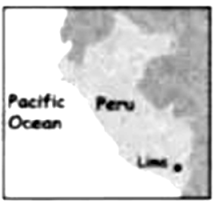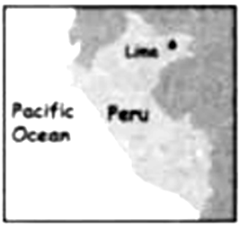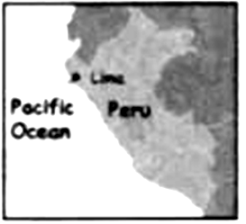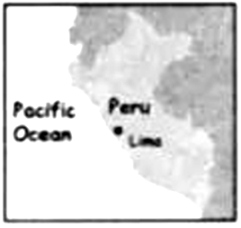—Certainly. I'm going to the countryside to visit my grandparents.

"Where could Michael be?" I wondered aloud.
Michael was my classmate. He liked playing pranks on others.
He once put a sign that said "Sing to Me!" on 1 back. It was terrible. Everywhere I went, people I didn't even know started singing to me. When I realized what was happening, I got really 2.
Another time, he embarrassed Nicole during sharing time. Nicole was shy. She3shared; she always said, "Pass." But what did Michael do when it was his turn to share? He asked, "Did everybody 4 how Nicole's new blue dress matches her eyes?" Nicole's face turned bright red. Poor Nicole!
It was Valentine's Day that day. I was sure Michael was up to something somewhere, 5 he always was. No way was I going to let him pull a prank — ruining someone's Valentine's Day.
I 6 him everywhere. Lunch break was almost over. I must find him and stop him. When I got to the classroom, there was Michael Peterson, at Michael Rogers's desk, digging in his 7 of valentines!
"Hurry and help me," said Michael as soon as he 8 me.
At first I thought he was stealing valentines from Michael Rogers's box. However, the more I watched, the more puzzled I became. He was putting valentines 9.
Seeing my expressions, he told me that he found Michael Rogers's box was 10 when he was passing out his valentines. Michael Rogers was new and Mrs. Karcher must have forgotten to put his name on the list, so11 made him a card.
I suddenly realized I had also 12 to prepare a valentine for Michael Rogers.
"But everyone made one for me," Michael continued* "So I'm giving him my13. since we've got the same name — Michael."
I stood there, not quite believing 14 I was hearing. "Is Michael Peterson the one who always pulled pranks on us?" I asked myself. Maybe he was kind of 15… in a hidden sort of way.

Every year, tens of thousands of kids aged 3 to 13 become Junior Rangers in different national parks across America. At Yosemite alone» more than 20,000 kids take part in the Yosemite Junior Ranger Program. If you want to be a Junior Ranger, you need to learn about the natural and cultural history. and make a promise to be a national park protector.

Here Is How YOU Can Become a Junior Ranger!
Earn yourself an official Junior Ranger Badge! You could become a Yosemite's Junior Ranger today by completing the following steps:
●Buy your Junior Ranger Handbook in the nearest Visitor Center.
●Complete the pages in the handbook.
●Pick up rubbish.
●Attend a Guided Program.
●Return your completed handbook and a bag of rubbish to the Visitor Center.
●Make your official Junior Ranger Promise at a ceremony.
●Get your official Junior Ranger Badge.
After you become a Junior Ranger, you are encouraged to share your ranger stories with your friends, teachers and families.
Lima, the capital of Peru, is located in the central coastal part of the country, overlooking the Pacific Ocean. With a population of more than 9 million, Lima is one of the largest cities and the only capital in South America that faces the ocean.
Lima has a long history. The lost Inca civilization, is thought to be a mystery. There are many museums, where you can learn: how the ancient American Indians founded the Inca Empire and built Machu Picchu, a famous ancient city in the Andes Mountains; what happened in 1532 and why over 90% of Peruvians speak Spanish. Visiting the historic center, a World Heritage Site, you may find you are communicating with both the past and the present.
Lima is also a place where you can find the lifestyles and fashions, created by its people and culture. You will see Peruvian clothes, dances, and taste their delicious foods and drinks. You can see buildings in different styles, enjoy the fantastic sunset over the ancient ruins, climb the mountains, fly over the ocean, or sit in the restaurants and bars to experience Peruvians' relaxing life.
You may have heard "It never rains in Lima. " In fact, the special geographic feature makes it not as dry as it is said to be and it is warm all year round. Though it seldom rains in summer, it sometimes drizzles on early winter mornings. The drizzle and the wet air "water" the ground, which makes the crops and the plants grow. Moreover, modern technology helps to bring water from the snow and ice on the top of the Andes (over 6,000m high) for the city to use. People there never waste water.
Lima is such an amazing city that it is worth a visit.
 B .
B .  C .
C .  D .
D . 

Most viruses can be found and killed by our immune system as soon as they enter our bodies. However, some viruses, for example, the coronavirus, are sneaky. They are difficult to recognize and find. These viruses can cause deadly diseases, like COVID-19. Human-to-human transmission can easily occur, and pandemic will therefore break out. Vaccination is by now a simple, safe and effective way to protect us from the diseases.
▲ Vaccines are something that "looks" exactly the same as the viruses, mainly made from the viruses that are weakened or killed. They will not make us really ill. They only stimulate and activate * our immune system to work, telling it something harmful is coming in. The immune system will know what the "viruses" look like, and send B cells(lymphocytes) or antibodies to find and kill them. Meanwhile B cells will remember them for the next kill. A vaccine may also give us passive immunity by providing B cells taken from an animal or a human to play the same role.
Scientists have developed more than 180 vaccines to fight against COVID-19. The technical approaches of these vaccines can be a little different, but their aims are the same.
Take the inactivated vaccine as an example. In an inactivated vaccine, the coronaviruses are already killed or made into the ones unable to produce more new viruses. When the immune system "sees" them, it will try to kill them. The question is: without enough these viruses• how can B cells remember them? That's why we need to take the vaccine more than one time. Though this vaccine is safe, it might not be as effective as it is expected to be.
The live-attenuated vaccine is different. In this vaccine, the viruses are weakened, but they are alive. They can produce enough new viruses to train the immune system to kill and remember them, so people only need to take the vaccine once. The live-attenuated vaccine is considered the most effective, but there is a worry: what might happen once these viruses wake up?
Therefore, although vaccination is by now one of the best ways to protect us from COVID-19, it can be better.
Newspapers are dying. Electronic devices like mobile phones pads, TVs and car radios can all be the killers. Most people believe in the long run, there is no reason• no practical reason for newspapers to survive. No matter what we do may only buy time.
Can anything save newspapers? I decided to have a try.
Many years ago, Bonnier, a Swedish publisher, set a newspaper in the former Soviet countries. After a few years, they had more newspapers in central and eastern Europe. However, these newspapers were run by a group of inexperienced people, and they didn't have enough money. In many places there were not even art directors.
I got a position in Bonnier's newspaper as an art director.
It was very difficult at first. I was really disappointed until one day, in London, when I saw performance by Cirque du Soleil. "These guys took some run-down entertainment, and put it to the highest possible level of performance art." Inspiration lighted me up, "Why can't we do the same with the newspapers. We started to redesign the newspapers, one by one.
We used our imagination. We treated the whole newspaper as one piece, one composition — like music.
Music has a rhythm, has ups and downs. Design is responsible for this experience. Flipping through pages was readers' experience, and I was responsible for this experience.
The front page became my personal channel to talk to the readers. My approach was simple and direct. I wanted to show my understanding of art, and of reality. I wanted to make posters, not newspapers. Not even magazines: posters.
We had determination, and we kept on trying. We experimented with type, with illustration, and with photos. We kept asking: Why do we do it? What's our goal?
Design was not only about the front page. It was a part of the process. To be good was not enough. The process we made was about improving the product completely.
We adjusted the content accordingly. We improved everything to what our readers thought it should be and how they liked reading it. We kept improving, and we had fun.
Soon in Poland , our pages were named "Covers of the Year" three times in a row. One year later, this newspaper, in the same country, they named it the "World's Best-Designed Newspaper". Two years later, the same award came to Estonia. The circulation of the newspapers kept going up. They became more and more popular.
Someone may think we are buying time, but our newspapers are alive, and growing.
|
she send except December successful |
Until recently, Ajayi had never gone to school. Now fifty, she attends a school in Ilorin* Nigeria, wearing the same pink dress as two (百)other girls at the school. She studies with the students nearly forty years younger than she is.
Ajayi runs her (自己的)business making and selling bags, but she believes it is (仍然) necessary for her to learn to read and write.
In class, she answers questions (积极). She plays, talks and (讨论)together with her classmates.
She is good at (烹饪). Children all like the food she makes. They enjoy (她们自己)at school.
Ajayi's (女儿) used to feel embarrassed about their mother's attending school with children. But now. they choose (支持)her efforts.
She plans to continue her (教育)for four more years, saying it will help her business.